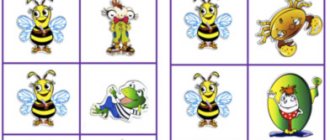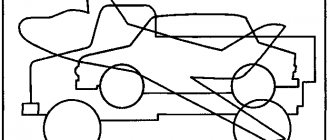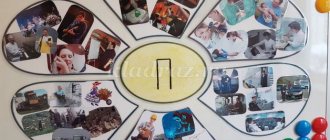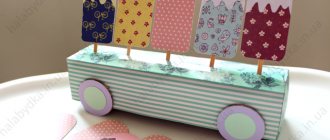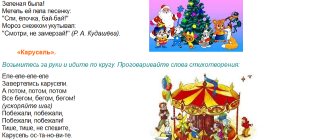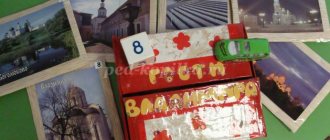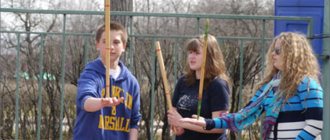Entertainment “Favorite Toys” in the middle group
Entertainment scenario “Favorite Toys” in kindergarten for middle group children without preparation
Goal: creating a favorable emotional state, expanding knowledge about toys. Objectives: 1. Create a positive emotional mood. 2. Activate children’s existing knowledge and skills. 3. Form play activities. 4. Develop tactile memory, logical thinking, agility and endurance. 5. Cultivate a caring attitude towards toys.
Progress of the entertainment
Host: We have a lot of different holidays every year, which ones can you name, for example? Children: Birthday, New Year, March Eighth Presenter: But we don’t have a holiday that would be dedicated to our toys. From early childhood we are surrounded by various toys. Let's all celebrate our favorite toys together today. Host: I also had a favorite toy as a child. I was rarely apart from her. Want to know what toy this is? Children: Yes! Presenter: you must guess the riddle . He is my favorite toy, He sleeps with me on the pillow. We walk with him together - We live together happily! I read books to him - This is my teddy... (bear)
.
Host: My grandmother told me that at night all the toys come to life. And I always wanted to play with them. Let's play with the bear and do a warm-up. Ready? The warm-up “The bear cubs lived in the thicket” is being performed. The bear cubs lived in the thicket, twisting their heads. Like this, like this – twisting their heads. (Turns the head to the right and left)
The cubs were looking for honey, rocking the tree together. Like this, like this – they rocked the tree together.
(Tilts the body to the right and left)
And they walked around and drank water from the river. That’s how, that’s how they drank water from the river.
(Bends forward)
And they danced!
Together we raised our paws! Like this, like this, they raised their paws up! (Alternately raise their hands)
There’s a swamp on the way!
How can we cross it? Jump and jump! Jump and jump! Have fun, my friend! (Jumping up) Host: My little bear wants to be played with. Outdoor game “Teddy Bear” Teddy Bear, Teddy Bear, Children and an adult walk in a circle. Stop sleeping, in the center of the circle there is a little bear toy. Stop sleeping. We want to be with you, bear. The children begin to run in a circle. Play, play. They stop and clap their hands. You are cheerful children. The children run away, the “bear cub” catches up. Catch up, catch up. Come on, bear, come on, bear, catch us, catch us. Host: While we were warming up and playing, we received a package from a toy store. I will tell you riddles, and by guessing them, you will find out what is in the package. Ready? He is funny and funny. He jumps together with me. He jumps deftly like a bunny. Striped, round...... (Ball) The game “Pass the ball” is being played Presenter: But there is something else in the package. Round, smooth, like a watermelon... Any color, for different tastes. If you let him off the leash, he will fly away beyond the clouds. (Balloon) Games with a balloon First game: Run with the ball around the pyramid, pass it to the next person Second game: Jump with the ball between your legs around the pyramid Host: And there’s still a toy left in the package, guess which one? Amazing child: Just out of diapers, Can swim and dive, Like his own mother. (duckling) Host: And the duckling whispers in my ear that he wants to dance the dance of the little ducklings with you. Dance of ducklings Host: Friends, look, who is sitting there, bored? Children: Dog. Host: Now let's have some fun. (Takes a toy - a dog)
.
Game “Shaggy Dog” Here sits a shaggy dog, burying his nose in his paws. Quietly, quietly he lies, either dozing or sleeping. Let's go up to him, wake him up and see: what will happen? Children approach the dog. As soon as the poem ends, the dog gets up and barks. The children run away, the dog chases after them and tries to catch one of them and take them to him. When all the children hide, the dog returns to his place. Presenter: Well done! That's how clever and fast you are. Host: kids, who is this riddle about? He is cheerful, lively, and with a propeller behind his back, he lifts his spirits, loves sweet jam, and always makes the baby laugh. Who is this? Tell me! (Carlson) Carlson appears. Carlson: Well done, guys, you solved all the riddles. (Takes candy out of his pocket)
.
I wanted something sweet. Host: Wait, Carlson, you can play with the candy. Let's see who can run with the candy without dropping it. Carlson: Well, that's easy. It's much more difficult to run without eating it. Host: So let’s see who can cope with this “difficult” task. Game “Candy in a Spoon” Children run around the pyramid, holding the candy in a spoon. Host: Kids, maybe we can draw our favorite toy and give it to Carlson. Children draw Carlson: Thank you, my friends. I really love sweets. You probably love it too? I am treating you all to a very tasty candy. You deserve it. Presenter: We played with toys, We read poems about them, We danced together. And now the time has come for us to part, friends.
We recommend watching:
Scenario for summer fun in the middle group Scenario for summer fun for Children's Day in kindergarten Methodological development of a scenario for summer fun for children in the middle group Outdoor fun in kindergarten in the middle group in the summer
Similar articles:
Scenarios for summer holidays and entertainment in kindergarten. Middle group
Lapbook “Toys”. Didactic games for primary preschool age
Yulia Sochilova
“Toys” Lapbook. Educational games for preschoolers
Lapbook. Toys. (for younger children)
This laptop can be used to introduce toys on the topic “Toys”, you can repeat the topic “Toys”. Lapbook is inert in working with children in groups and individually, as well as in relation to lessons in the evening, outside of lessons, parents can consolidate their knowledge on the topic of toys together with their children. This laptop includes a variety of educational games: 1 One-Many Educational Game. Goal: to develop the ability to distinguish between the number of objects, many and one.
.2, didactic game Dress the doll Purpose: to teach children to choose and name suitable clothes (for girls. For boys to develop aesthetic taste.
.3 didactic game The fourth extra object Purpose: to strengthen in young children the ability to find the fourth extra object and explain why the object is extra.
.4 didactic game Circle and color Purpose: To develop fine motor skills, a sense of color, perseverance, and accuracy in young children.
.
.5 educational game Find my shadow Purpose: to teach young children to find given silhouettes of objects, animals, toys; develop children's visual perception, attention, and observation skills.
.
.6 didactic game Dress up the matryoshka Purpose: to teach young children to memorize geometric shapes (circle, square, rectangle, triangle, teach to group objects by color, correlate geometric shapes by shape by overlapping.
.7 educational game Cropped pictures Purpose: to teach young children to form a whole consisting of two parts, to develop logical thinking, visual perception, and attention.
What else to read: Mathematical games for developing the intellectual abilities of preschoolers
.8 educational game Consider and color Goal: to develop visual perception in young children, the ability to guess and name a toy, choose the color of a pencil for coloring a toy, the ability to hold a pencil correctly, develop fine motor skills, develop accuracy and consistency,
.
.
.9 didactic game with lacing My toys Purpose: to teach young children to correctly name a toy according to its external characteristics according to poems read by adults in order to make up a story about this toy (why do you need such a toy, like plays with it, the one who plays with it, develops and replenishes vocabulary, finds the necessary parts of the toy and connects with a rope, develops fine motor skills.
educational game .ten Collect a picture Purpose: To introduce young children to a variety of toys, do exercises on creating pictures from geometric shapes (you can use a constructor)
develop sensory perception of fine motor skills of the hands.
